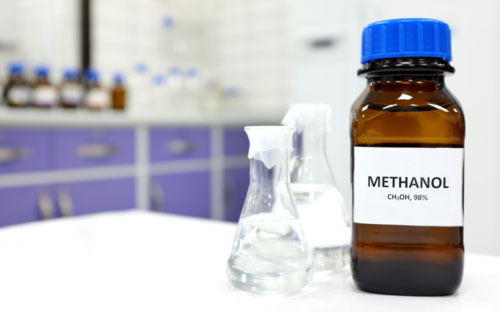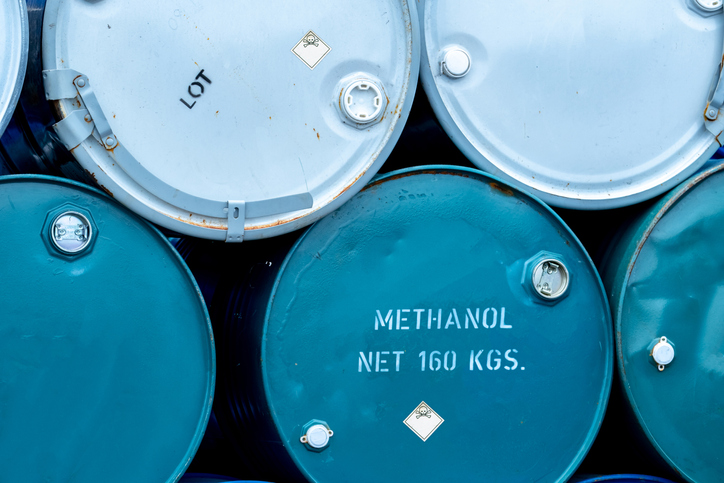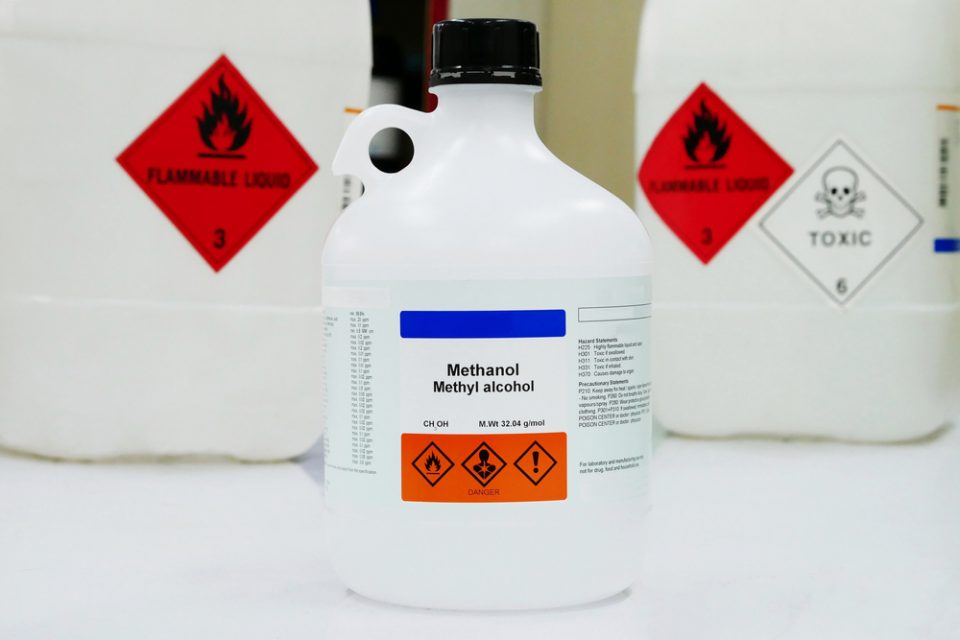Methanol – CAS# 67-56-1
Bulk Order
Methanol is a highly important chemical with numerous applications in the global chemical industry. It is also a potential clean fuel and hydrogen source due to the predicted future shortage of energy resources. The production process involves feedstock desulfurization, reforming, synthesis, and distillation, producing pure methanol with a high AA purity grade. China, Japan, Korea, India, Singapore, Taiwan, and Western Europe are the primary target markets for methanol exports from the Middle East, reflecting the high demand for this versatile chemical.
Bulk order a light, colorless, volatile liquid with faintly sweet methanol. The pungent odor is similar to that of ethanol. Unlike ethanol, it is poisonous for human consumption. Virgin Methanol is the simplest alcohol. Vapors are slightly heavier than air.
Methanol Tech, Methanol Reagent Acs, Methanol HPLC, Methanol, LAB, Methanol USP NF, Methanol Pesticide, Methanol Off Spec, Methanol Optima Grade, Methanol Spectographic Grade
| Market | Reagents, Solvents, Featured Stocked Products |
|---|---|
| Class | Alcohols |
| MOLECULAR WEIGHT | 32.04 |
| APPEARANCE | Colorless liquid |
| DENSITY | 0.791 g/cm3 |
| REFRACTIVE INDEX | 1.329 |
| COLOR | < 10 |
| ASSAY | ≥ 99.9 % |
| WATER CONTENT | < 0.03 % |
| BOILING POINT | 64.7 °C |
| MELTING POINT | −98 °C |
ISO 9001, ISO 14001, ISO 13485, and ISO 45001
Distributing of bulk Methanol.
Available in 5 gal pails, 55 gal drums, 275 gal totes,
What is the Methanol?
The feedstock for the methanol unit undergoes desulfurization along with steam. It enters the reformer, where it is converted into synthesis gas containing hydrogen, carbon monoxide, and carbon dioxide at a temperature of approximately 900 degrees Celsius. The produced synthesis gas is compressed after cooling and is transformed into crude methanol in the synthesis section reactors. After separating the available water, pure methanol with AA purity grade is produced in the distillation unit.
What Methanol Used For?
Methanol is one of the strategic products in producing various final products such as solvents, dyes, plastics, and antifreeze. The versatility of methanol derivatives and their use in various industries have made it a prominent strategic commodity. As a result, its price fluctuations impact many manufacturing industries.
Most methanol produced worldwide is used to produce formaldehyde, acetic acid, and MTBE. Acetic acid (ethanoic acid, CH3COOH, C2H4O2) has a long history and is commonly known as vinegar. Humans have had access to this substance since ancient times through non-synthetic and predominantly fermentation and distillation methods. It has been used in the production of food, pharmaceuticals, and industries such as leathermaking and the preparation of dyes.
Acetic acid is industrially synthesized through various synthetic methods. One of these methods is synthesizing acetic acid from methanol and carbon monoxide (carbonylation). Acetic acid produces vinyl acetate, ethyl acetate, isopropyl acetate, butyl acetate, acetyl chloride, monochloroacetic acid (MCA), and ketene.
Are produced due to the reaction between monomethyl amine and ethylene oxide. These compounds are used in pharmaceuticals to absorb and separate CO2 and H2S compounds from natural gas. Other applications of monomethyl amine include the production of the surfactant methyl taurate, which is used in the textile and detergent industries, as well as the production of substances such as dimethyl urea, caffeine, and explosives, where monomethyl amine nitrate is used.
It is widely used as a solvent in producing lubricating oils. In this process, NMP separates benzene, toluene, and xylene. Furthermore, due to its low toxicity, this compound can substitute methyl chloride as a solvent in producing dyes and is also used in polyimide coatings and cables.
Formaldehyde is produced industrially through the catalytic oxidation of methanol. Silver metal, a mixture of iron oxide and molybdenum, is commonly used as a catalyst. When iron oxide and molybdenum are used as catalysts, methanol reacts with oxygen at a temperature of 400 degrees Celsius. Formaldehyde is used as a disinfectant solution due to its ability to eliminate bacteria. It is also used for preserving biological specimens. The primary use of formaldehyde is in producing polymers and other chemical compounds.
Formaldehyde resins are created by the reaction of formaldehyde with phenol, urea, and melamine. These materials are commonly used as adhesive resins in producing plywood, molded foams, and insulation foams. Formaldehyde is also used to produce polyformaldehyde, EDTA, resorcinol, novolac, phenol formaldehyde, pyrrolidone, methyl pyrrolidone, polyesters, etc.
MTBE is a gasoline additive used to increase the octane number of fuel, and it is produced from methanol and isobutylene. MTBE was the first oxygenate considered as an additive to gasoline to enhance the complete combustion process. Methanol, which is a primary component of MTBE, is often derived from natural gas and other petroleum products. MTBE is primarily used as an oxygenate in fuel. After the phase-out of tetraethyl lead in many countries, MTBE is used for oxygenating gasoline through the addition process. The desired octane number is achieved by adding MTBE instead of tetraethyl lead.
One of the processes involves the catalytic conversion of methanol and/or dimethyl ether into a mixture of olefins. In this process, raw methanol is converted to ethylene and propylene. In the first step, natural gas is converted to raw methanol, and in the second step, the obtained methanol is converted to ethylene and propylene through a catalytic reaction. This process’s significant feature is converting the primary component of natural gas (methane) into olefins. Methane constitutes about 90% of natural gas, making its conversion to olefins highly cost-effective. The produced ethylene and propylene have a purity of over 97% and can be easily separated and sent to the polymerization unit.
The economic viability of this process depends on factors such as the price and market demand for olefins, the cost of methanol feedstock, catalyst cost, and plant location. Different markets for ethylene and propylene exist in various regions. In the US and Europe, the demand for ethylene is often higher than for propylene, while in Asia-Pacific, the demand for propylene exceeds that of ethylene.
Methylamine, also known as monomethyl amine or amino methane, and dimethylamine, known as methyl methane amine, are chemical compounds. They exist as gases with an ammonia-like odor at room temperature and are soluble in water, alcohol, and ether. They are highly flammable and toxic in their pure form. Monomethylamine produces methyl isocyanate, a raw material for producing pesticides such as carbaryl, simazine, bromide, carbophenothion, and carbofuran. Additionally, methylamine synthesizes toxic compounds such as methylamine and examine.
Methanol Industry Used
This substance is used in the production of the following materials:
- Adhesives and sealant chemicals
- Adsorbents and absorbents
- Agricultural chemicals (non-pesticidal)
- Anti-adhesive agents
- As an ingredient in a wide variety of products
- Bleaching agents
- Corrosion inhibitors and anti-scaling agents
- Dyes
- Fuels and fuel additives
- Functional fluids (open systems)
- In antifreeze
- In chemical synthesis
- Intermediates
- Ion exchange agents
- Laboratory chemicals
- Odor agents
- Oxidizing/reducing agents
- Paint additives and coating additives
- Solvents for cleaning and degreasing
- Solvents that become parts of product formulation or mixture
- Solvents for paints and plastics
- To remove water from automotive and aviation fuels
- Used in the manufacture of formaldehyde and acetic acid
Methanol Safety Procedures
Methanol is a hazardous substance that can be harmful if inhaled, ingested, or in contact with skin, and therefore it is essential to take appropriate precautions when handling it. Personal protective equipment (PPE) must always be worn, and the chemical should be stored in tightly closed containers away from sources of ignition and direct sunlight. The liquid and vapor of this product are highly flammable, and the vapor can travel and ignite if allowed to accumulate in a confined space.
It is critical to use this chemical in a well-ventilated area, avoid breathing vapors, and wash any exposed skin thoroughly after handling. To minimize the risks associated with methanol, staff must be aware of the safety procedures to follow. This includes storing it away from open flames or sources of ignition, ensuring adequate ventilation, and using a fume extraction system to remove any vapors from the working area.
Additionally, it should not be disposed of in the drainage system but rather in accordance with appropriate waste regulations. Storage containers must not be left open as this can result in the evaporation of harmful contents. Staff must be trained to handle spillages or evacuation if necessary.


